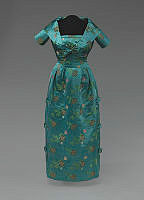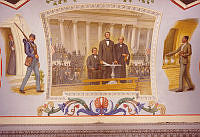Rubenstein Center Scholarship
Washington, D.C.'s "Contraband" Camps
This article is part of the Slavery in the President’s Neighborhood initiative. Explore the Timeline
On April 16, 1862, Congress passed the Compensated Emancipation Act, ending slavery in the District of Columbia and delivering long-awaited freedom to more than 3,000 men, women, and children.1 America’s capital city became a beacon of liberty for enslaved individuals in bordering slave states like Maryland and Virginia, many of whom ran away and crossed into the District to pursue their own liberation from bondage. While the Civil War raged, the population of Washington, D.C. transformed into one of soldiers, politicians, and African-American freedom seekers.
Although Washington, D.C. was a territory without slavery after 1862, these refugees were not completely free from the shackles of bondage. Until 1864, the Fugitive Slave Act of 1850 remained federal law; technically, “fugitives” could be returned to their owners in the South even after reaching Washington, D.C. and other free states in the North. In March 1862, Congress passed an article forbidding the return of enslaved individuals by military personnel, but bounty hunters still exploited the chaos and lack of organization in refugee settlements to their advantage, capturing formerly enslaved individuals and returning them for a profit.2
However, some northerners opposed this controversial law, including Union Major General Benjamin Butler, who ostensibly coined the term “contrabands of war” when referring to fugitive slaves that crossed into Union-controlled territory.3 By calling runaway enslaved men and women “contrabands,” they were considered Confederate property confiscated by the Union enemy during wartime, circumventing the Fugitive Slave Act and essentially transferring enslaved individuals from Confederate to Union property. Congress solidified the status of these “contrabands” via the First Confiscation Act which declared:
…any property of whatsoever kind or description, with intent to use or employ the same, or suffer the same to be used or employed, in aiding, abetting, or promoting such insurrection or resistance to the laws… is hereby declared to be lawful subject of prize and capture wherever found; and it shall be the duty of the President of the United States to cause the same to be seized, confiscated, and condemned.4

This drawing by Edwin Forbes, originally captioned: "Coming into the lines. A party of slaves...have started for the Union lines,” depicts the movement of “contraband” individuals during the Civil War.
Library of CongressPresident Abraham Lincoln signed the bill into law in August 1861.5 The act was imperfect in many ways and did not grant absolute freedom to enslaved individuals, but one year later, the Second Confiscation Act expanded and clarified its predecessor and shaped Lincoln’s development of the Emancipation Proclamation. These congressional acts set precedents for the quasi-freedom and settlement of formerly enslaved men and women across the capital but muddied their legal status. As “contrabands of war,” were they really free, enslaved or something else entirely?
“Contraband” African-American refugees quickly became an integral part of wartime Washington, D.C.’s landscape.6 Without money, food, or shelter, these runaways had left behind everything for freedom—but the federal government, strained by war, was slow to provide assistance. At the start of the Civil War, incoming refugees were housed in the Old Capitol Prison on Capitol Hill, but later moved to a group of tenement houses nearby called Duff Green’s Row during the spring of 1862.7 Harriet Jacobs, a formerly enslaved activist, documented the abysmal conditions at Duff Green’s Row:
I found men, women and children all huddled together, without any distinction or regard to age or sex. Some of them were in the most pitiable condition. Many were sick with measles, diptheria [sic], scarlet and typhoid fever. Some had a few filthy rags to lie on; others had nothing but the bare floor for a couch.8 Plagued by overcrowded accommodations, unsanitary conditions, racism, and a preoccupied federal government, refugees wondered: “Is this freedom?”9

Elizabeth Keckley, a formerly enslaved woman and activist who worked as First Lady Mary Lincoln's dressmaker.
Virginia Commonwealth UniversityFortunately, formerly enslaved men, women, and children who fled to D.C. had an ally in the White House: Elizabeth Hobbs Keckley. Keckley, too, had once been enslaved but purchased her own freedom, later becoming First Lady Mary Lincoln’s dressmaker and companion. Because of her aptitude for fashion and powerful political connections, Keckley was a well-known, respected African-American woman in Washington, D.C. She often used her status to advocate for various causes in the city, including the improvement of conditions in contraband camps. In the summer of 1862, Keckley spearheaded the creation of a philanthropic organization to aid formerly enslaved refugees, called the Contraband Relief Association.10 The Association’s forty members raised funds to provide clothing, food, and bedding to camps throughout the capital. Keckley approached Mrs. Lincoln about the prospect of donating to the cause in September 1862 and the first lady agreed. On November 3, 1862, Mary wrote to her husband at the White House:
My Dear Husband, I wrote you on yesterday, yet omitted a very important item. Elizabeth Keckley, who is with me and is working for the Contraband Association, at Wash[ington]— is authorized…to collect anything for them here that she can. She has been very unsuccessful. She says the immense number of Contrabands in W[ashington] are suffering intensely, many without bed covering & having to use any bits of carpeting to cover themselves. Many dying of want. Out of the $1000 fund deposited with you by Gen Corcoran, I have given her the privelege of investing $200 her, in bed covering. She is the most deeply grateful being, I ever saw, & this sum, I am sure, you will not object to being used in this way. The cause of humanity requires it…Please send check for $200…she will bring you on the bill.11
According to Keckley’s memoir, the Lincolns donated to the contraband cause throughout the Civil War, as did other prominent leaders, including abolitionist Frederick Douglass.12
President Lincoln also personally encountered contraband camps during his daily summer commute to northeast Washington, D.C. During the city’s humid summer months, Lincoln and his family elected to reside at a cottage adjacent to the Soldiers’ Home, a home for veteran retirees. The elevated location provided a cool summer breeze and removed the Lincolns from the crowded chaos of downtown Washington. Still, President Lincoln regularly commuted back to the White House for meetings, and during these daily carriage rides he directly passed D.C.’s contraband camps—particularly Camp Barker, located only a mile from the Executive Mansion near present-day Logan Circle.13
The Lincolns also frequently interacted with a camp resident—Mary Dines, a formerly enslaved runaway hired to be the Lincolns’ cook at their summer cottage.14 Dines, called “Aunt Mary” by the Lincolns, also occasionally worked as a cook at the White House.15 While laboring at the most famous home in America, she lived at a nearby contraband camp, and told Lincoln biographer John E. Washington that President Lincoln stopped to speak with refugees at a local camp many times on his way to the Soldiers’ Home. Dines remembered an instance when Lincoln stayed to watch a performance of “Negro spirituals” and shed a tear mid-song.16 Dines also told Washington that “Mrs. Lincoln contributed money and sent gifts to older people” at the camp.17 These oral histories cannot be taken as categorical historical evidence as no other reference to Lincoln’s visits remain; nevertheless, Lincoln’s regular proximity to the camps conceivably made an impression on his outlook on slavery. Click here to read more about the household of President Abraham Lincoln.

President Lincoln passed contraband camps during his daily commute between the White House and the Soldiers’ Home, seen here.
Library of CongressPresident Lincoln’s 1863 Emancipation Proclamation, which he drafted the previous summer at the cottage, intensified the influx of formerly enslaved individuals to D.C.’s refugee camps. As approximately 10,000 new refugees made their way to the capital from Confederate-held territory, the need for accommodations in and around Washington increased.18 Overcrowded outdoor camps dotted the city and extended into surrounding Union-held territory in Northern Virginia. Some offered barrack-like housing or tenement buildings, and others relied upon semi-covered encampments and tents to accommodate thousands of refugees. Cramped quarters, contaminated water, and poor sanitary conditions in present-day Brightwood, Theodore Roosevelt Island, Arlington, Dupont Circle, and Adams Morgan produced deadly outbreaks of smallpox, typhoid and pneumonia.19 Though the conditions, permanence, and governance of these camps varied from location to location, many refugees felt that their new life in freedom was scarcely better than bondage. Elizabeth Keckley wrote in her memoirs:
Thousands of the disappointed, huddled together in camps, fretted and pined like children for the “good old times.” In visiting them in the interests of the Relief Society of which I was president, they would crowd around me with pitiful stories of distress. Often I heard them declare that they would rather go back to slavery in the South, and be with their old masters, than to enjoy the freedom of the North. I believe they were sincere in these declarations, because dependence had become a part of their second nature, and independence brought with it the cares and vexatious of poverty.20

John E. Washington wrote in his book, They Knew Lincoln, that Mary Dines gifted him this photograph. It depicts the residents of Camp Barker as they prepared for Lincoln’s visit.
National Archives and Records AdministrationCamp conditions were undesirable in most ways, but there were also opportunities for education, religious practice, and community-building.21 These provided a significant intellectual and spiritual outlet for formerly enslaved individuals, many of whom had no access to education while held in bondage or were not permitted to openly practice the faith of their own choosing.
In return for government-sanctioned accommodations, rations, and access to hospital facilities, able-bodied refugees were expected to work on behalf of the federal government or Union Army; a new Contraband Department within the Quartermaster Department of the U.S. Army oversaw these efforts to employ African-American refugees and provide aid assistance.22 The government paid refugees wages and rations, albeit infrequently and often much less than their white counterparts, creating an exploitative work environment which to many felt only slightly better than slavery. Overworked and underpaid, able African-American men joined military construction projects, built fortifications, and some enlisted in the Union Army. Women and children worked in hospitals, cooked, and cleaned D.C. streets.23

African-American refugees at Camp Brightwood in Washington, D.C.
Library of CongressSome refugees in the D.C. area were also sent to former Confederate farmland in Union-controlled Northern Virginia to raise profits for the Union via farming. According to the Alexandria Gazette:
A portion of the contrabands at present at the Contraband Camp in Washington are to be immediately employed in cultivating General [Robert E.] Lee’s estate, at Arlington, and other abandoned farms in the vicinity, in Virginia, for the purpose of raising forage. All of the contrabands who are able to work and not otherwise employed will be at once put to work for this purpose.24
This labor mirrored the work of enslaved field workers in many ways. In fact, Washington D.C.’s Evening Star reported:
[Contrabands] seem delighted at the change from the hot, uncomfortable barracks in which they have been confined, to the open fields. The work they are engaged in is what they have been accustomed to and are peculiarly fitted for; and laboring under happier auspices than heretofore, they will no doubt be much benefitted.25

Map of contraband camp at Mason’s Island (now Theodore Roosevelt Island) in Washington, D.C.
National Archives and Records AdministrationIn 1863, government support for formerly enslaved men and women expanded to include new planned communities like the Freedman’s Village in Arlington, Virginia, built on Confederate General Robert E. Lee’s Union-confiscated estate.26 Colonel Elias M. Green and Danforth B. Nichols founded the Freedman’s Village as a model for a semi-permanent community for free African Americans. They hoped that the open-air, rural location of the settlement would rectify the sanitary conditions that had allowed disease to spread rapidly in crowded, urban places like Camp Barker. According to historian Joseph P. Reidy, the U.S. government intended the village to be a “stepping stone to self-sufficiency” and that “after a brief sojourn there, residents would seek employment and housing elsewhere in the capital area, thereby making room for new arrivals.”27 While this was the case for some, the Freedman’s Village remained a flourishing black community in the D.C. area long after the end of the war. Perhaps most importantly, the symbolism of living on the former property of Lee was not lost on previously enslaved residents.28

Drawing of the Freedman's Village in Arlington, Virginia in 1864.
Library of CongressDespite the many contributions that formerly enslaved African Americans made to the war effort, they still faced racism among northerners and within the Union Army. In Union-controlled Natchez, Mississippi, for example, a Union surgeon ordered the removal of unemployed contrabands, calling them: “lazy and profligate, unused to caring for themselve…the most of them load idly about the streets and alleys, prowling in secret places, and lounge lazily in crowded hovels, which soon become dens of noisome filth…”29 Meanwhile, exploitation within D.C.’s contraband camps by white camp superintendents was all too common. Danforth B. Nichols, superintendent of Camp Barker and later the Freedmen’s Village in Arlington, often received complaints of tyrannical, abusive behavior toward his camp wards.30 Many white Americans who opposed slavery still did not see African Americans as their social equals, further straining the lives of refugees as they sought liberty and equality in the North.
In the final two years of the Civil War, the influx of African-American refugees in Washington, D.C. swelled; historians estimate that by 1865, approximately 40,000 formerly-enslaved men, women, and children had settled in the capital region.31 President Lincoln’s establishment of the Bureau of Refugees, Freedmen, and Abandoned Lands (also called the Freedmen’s Bureau) in March 1865 created a federally-managed body to oversee the protection of African-American liberties. Section Two of the “Act to Establish a Bureau for the Relief of Freedmen and Refugees” directly considered the fate of “contrabands” in post-war America.32 It stated:
…the Secretary of War may direct such issues of provisions, clothing, and fuel, as he may deem needful for the immediate and temporary shelter and supply of destitute and suffering refugees and freedmen and their wives and children, under such rules and regulations as he may direct.33
The transition from viewing these individuals only as property and integral to a slave-driven economy, to a nation of free African Americans, would not be an easy one. Following the assassination of President Lincoln, Andrew Johnson—a former slave owner— assumed the presidency; compared to his predecessor, Johnson was much less willing to prioritize the plight of African Americans in Washington, D.C. and across the United States. His mishandling of Reconstruction policy toward freedmen and women allowed violence, prejudice, and poverty to flourish in the American South. In this atmosphere of racial inequality and segregation, resilient black communities and neighborhoods grew in number, many of which originated in Civil War settlements and contraband camps.34 Click here to learn more about the formerly enslaved households of President Andrew Johnson.










